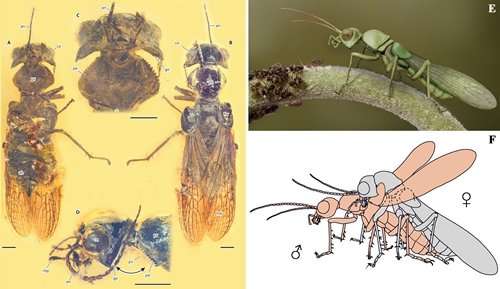Researchers describe unique cephalo-thoracic scissors in extinct insect species

Insects are the most diverse group of animals on earth, with more than 1 million species, and account for more than 50 percent of all living species, including bacteria, fungi, and viruses. Insects are divided into more than 30 insect orders, such as Coleoptera, Lepidoptera, Hymenoptera, etc.
In early 2016, a Sino-German collaborative research team discovered a new extinct insect order, †Alienoptera (Bai et al., 2016. Gondwana Research), in 99-million-year-old amber from Myanmar. The researchers report it to be a bizarre hybrid of several insect orders.
Insects use mouthparts, legs and other body parts to cling to mating partners, catch prey or defend themselves. Over 400 million years of evolution, specialized appendages evolved independently in several groups to perform these tasks. They include modified legs in mantids, assassin bugs and stick insects, and clasping antennae in globular springtails.
Until this new order was discovered, however, no known species used the neck region between the head and thorax for such functions.
The researchers describe females of the second new species from †Alienoptera, †Caputoraptor elegans, a very unusual, presumably predacious insect discovered in approximately 100 million-year-old Burmese amber based on a total of nine individuals from eight amber pieces. All specimens were scanned with μ-Ct devices at the Institute of Zoology of the Chinese Academy of Sciences, the Beijing Synchrotron Radiation Facility (BSRF), or the Shanghai Synchrotron Radiation Facility (SSRF).
Based on 2-D and 3-D data covering several morphological features, researchers concluded that this species lived in the foliage of trees or bushes. The most striking morphological feature of †Caputoraptor is a jack-knife mechanism with sharp edges of the posterior head meshing with toothed ridges on the anterior prothorax.
Such a configuration is not known from any other fossil or extant species. Although the musculature involved in the mechanism was not preserved in the specimens of †Caputoraptor, it is likely that the two ridges interacted like the blades of a scissors when the head was lowered.
Since the position of the eyes suggests that the field of vision of †Caputoraptor did not include the space between the ridges, sensory hairs most likely functioned as a trigger causing the cephalo-thoracic scissors to close. It is difficult to determine how and why †Caputoraptor used this unique mechanism.
However, based on the structure of the apparatus, researchers have hypothesized that the cephalo-thoracic device was a sexual-dimorphic structure of the female, used to cling to the male during copulation. A defensive or prey-catching function appears less likely. A similar mechanism did not evolve in any other known group of extant or extinct insects.
Females mounting males are known among several groups of insects, including grasshoppers, mayflies and roaches. The spread forewings of the males would fit perfectly with the cephalo-thoracic scissors of the females. These short, sclerotized structures would not be mechanically damaged between the ridges and would provide stable anchorage. Once the female achieved such a fixed position, copulation could take place with the female on top of the male.
More information: DOI: 10.1016/j.cub.2017.12.031
Provided by Chinese Academy of Sciences

















